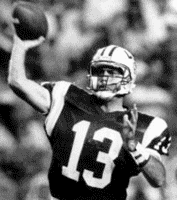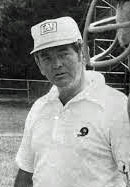|
LSU Short Story
A Passing Fancy
Marty Mule, Eye of the Tiger: 100 Years of LSU Football (1993)
When Wendell Davis came to LSU, no one could have imagined that he would even be a starter, much less an All-American receiver. It's funny how life turns out. Wendell Davis caught 183 passes in his LSU career, led the nation in receiving once with 80 catches, and the same season led the nation in touchdown receptions. Every one of those - and his school record 19 career touchdown catches - may have been caused by irregular yard lining in Tiger Stadium. Until 1985 there was almost no running room outside the north end zone. A player ran out of the north end zone directly into a fence. The south end zone, on the other hand, had several yards of cushion between the end marker and fence. On such miscalculations are All-Americans created. The field was altered in 1985, with the north end zone being moved out five yards. But before it was done, Glenn Holt, an up-and-coming LSU receiver, shot into the north end zone during spring training to make a catch. He made the reception near the end marker and, moving at full speed, couldn't stop himself from slamming into the fence. Holt put out his hand to break his momentum. He also broke his hand. The Tiger Stadium dimensions were adjusted shortly afterward, but the north end zone had claimed a victim. A bad break for Holt turned into the break of a lifetime for Davis. Davis, Holt's best friend and a second-string flanker who caught exactly zero passes as a freshman, was switched to split end. Holt never could win back his job, took ill and flunked out of school. Davis caught 31 passes as a sophomore, 80 as a junior and 72 as a senior, and was a consensus All-American his last two seasons. Whenever the Tigers needed a clutch play during their 9-3-0 Southeastern Conference championship of 1986, Tommy Hodson, the precocious redshirt freshman quarterback, invariably went to Davis. That, looking back, Hodson said, surprised him as much as it surprised opposing secondaries. Davis was given the last available grant-in-aid in the recruiting class of 1984. Hodson was the number one recruiting prize of 1985, a passer so pure he was thought of as a candidate for LSU canonization before he ever arrived on campus. Before he ever threw a pass for the Tigers, however, Hodson suddenly lost all feeling in his right arm. An injury in a high school all-star game resulted in a frayed nerve and threatened Hodson's career before it ever started. Hodson and Davis started working out together. Hodson, an accomplished passer, couldn't quite believe that Davis, who couldn't run under Hodson's long throws and couldn't hang on to his short ones either, was actually a major-college athlete. "I was not overly impressed," Hodson said diplomatically with a smile, "nothing exceptional." Davis did have a strong work ethic, though. He practiced tirelessly and ran precise, disciplined routes. He worked on his hand-eye coordination and eventually began making routine catches routinely. "The patterns," he said, "came before the hands." Then difficult catches began sticking in Davis' hands. His speed in the 40y dash improved from 5.0 seconds to 4.6. ...    L-R: Wendell Davis, Tommy Hodson, Bill Arnsparger "I thought he was a 28, 29-year-old pro player back for the weekend. He's an impressive person. I don't think anyone has stopped him." No one did. When Hodson recovered and took over the No. 1 quarterback duties as a redshirt freshman, he had a ready-made, polished target to throw to: Davis. Hodson passed for 2,261y and 19 touchdowns in 1986, the season his primary receiver, Davis, led the NCAA in total receptions and touchdown receptions. The pair was football's equivalent of the Dynamic Duo as LSU again won the SEC. There was more of the same in 1987 when the Tigers, clearly one of the nation's best teams, went 10-1-1. "Those first two seasons were storybook seasons," Hodson said. "We had really great personnel and won a lot of games." Davis left LSU as the SEC's most productive receiver (2,708y), and the No. 1 draft choice of the Chicago Bears. Hodson left two years later, after chalking up another league title, as the SEC's most productive passer. A case could be logically made that any school all-star team should include Hodson on its starting unit. No one ever quarterbacked LSU to as many victories (31), passed for as many yards (9,115), threw as many completions (674), or as many touchdown passes (69). He once split his tongue open in a game at Kentucky, then came back to steer LSU to victory. Against Georgia in 1987, Hodson took a vicious cheap shot 5y out of bounds and had to be replaced. Former LSU coach Bill Arnsparger, who had coached some of the best defenses in NFL memory at Miami, was then the athletic director at Florida and watching the televised Tiger-Bulldog donnybrook. "Don't worry about him," Arnsparger commented of Hodson. "That's the toughest kid I've ever been around." Hodson came back in to throw the winning touchdown pass in a 26-23 Bayou Bengal victory. Davis and Hodson, though they only played together two seasons, will forever be linked in LSU's collective memory bank. But, interestingly, while Davis became the object of multiple coverage - and media coverage as a hot story - Glenn Holt faded from LSU memory. During the spring of 1987, two years after Holt's ill-fated crash into the north end zone fence. Davis turned a corner in Orlando FL - and ran right into his old buddy. "We were both shocked," Davis said. "Neither of us could believe it for a minute." Holt was then an athlete at Western Kentucky and on his way to a track meet. Davis was on his way to a photo session with the preseason Playboy All-America team. They made small talk. Holt congratulated Davis, and then the friends said goodbye. |